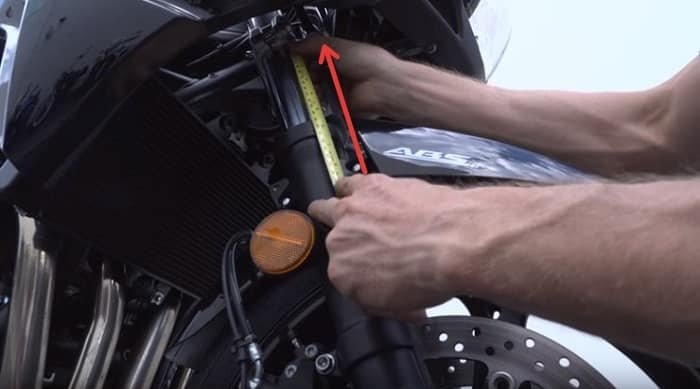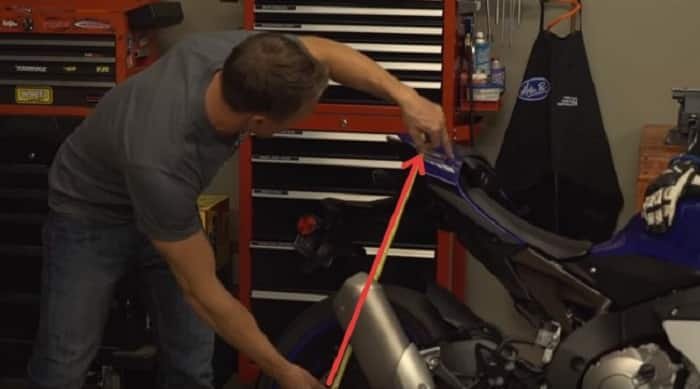If nature gave you short legs you may struggle with the seat height on your motorcycle, luckily there are a number of mods that can help you get the seat a little closer to the ground. There are three simple things you can do right now to adjust the height of your motorcycle seat.
There are five ways to adjust the seat height on a motorcycle
- Check Motorcycle Suspension Sag
- Lower Motorcycle Forks
- Adjust Forks Pre-Load
- Adjust Motorcycle Seat Height
- Use Lowering Links
Unless you ride a cruiser or a small displacement bike you’re likely looking at a seat height of around 31 inches, or even close to 33 inches.
Unless you’re 5 foot 6 or taller you may find it difficult or even impossible to get your feet on the ground at stops.
I do want to point out that while it’s nice and very confidence-inspiring to be able to put both of your feet on the ground, when you roll to a stop it’s really not necessary. One foot will suffice as long as you have the experience and the balance to pull it off.
However, if you want your seat to be a little bit lower so you can get your feet down you’ve got a few options. The very first thing you should do is check your suspension sag, if you’re short you might also be light in which case you’re shocked and fork springs could have too much preload on them.
That’s going to make your ride harsh but it’s also going to put the suspension higher in the stroke which is going to put your feet farther from the pavement. Checking your suspension sag is easy to do, it’s free, and it’s the very first step in setting up your suspension so that your bike behaves well.
How To Check Motorcycle Suspension Sag
Setting suspension sag is the very first step in setting up any bike suspension but do you know how to check and adjust sag?
The amount of suspension compresses under the weight of the rider is called rider sag or laden sag, an easy way to think about sag is as a measure of how much suspension travel is available to extend down into dips, like potholes.
Setting sag ensures that your rake, trail, ride height, and other important factors are within the right range and it’s also a great way to determine whether or not your springs are right for your weight or height.
As a general rule, sag should be about 1/3 to 1/4 of total suspension travel, which typically works out to about 30 to 40 millimeters for most sportbikes, naked and sports tourers.
To measure sag you’ll need the bike, the rider wearing full gear, a notepad, and a pen. A tape measure preferably a metric one and any tools needed to adjust your bike’s front and rear preload.
If you have a front-wheel chock that’s going to be really helpful otherwise plan on working next to a wall so the rider can reach over and balance himself while you take some measurements.
I’ll be explaining the race tech method of checking suspension sag, it’s a little more involved but I feel it’s a lot more accurate because it takes into account drag within the suspension components.
How To Lower Motorcycle Forks
Start with the front of the bike, you need to measure the suspension fully extended. If your bike has a center stand that’s pretty easy if your bike doesn’t have a center stand ask your rider to carefully lean the bike over on the side stand so the front wheels off the ground then measure the exposed portion of the lower fork leg.

If your bike has a right side up fork measure from the axle to the lower triple clamp, write this number down and mark it as L1. First, we’re going to press down on the suspension and then let it rise slowly, this is going to be our L2 measurement. Once again you’re measuring the exposed fork slider.
Then lift up on the front of the bike and then let it settle gently, once again measure the exposed portion of the lower fork leg, this going to be our L3 measurement.
If there is no drag or friction within the fork the L2 and the L3 measurement would be the same. Now let’s do a little math to find out what the SAG figures actually are.
You need to average L2 and L3 and then subtract that figure from L1 so the total equation is L1 minus L2 plus L3 divided by 2.
Remember the figure should be about 30 to 40 millimeters if it’s more then you need to add some preload in order to bring the SAG figures into the appropriate range of between 30 to 40 millimeters.
How To Adjust Your Forks Pre-Load
Adjusting the preload is pretty easy, you just have to turn the adjusters on the top of the fork, your bike will be different to others so just check your owner’s manual to see if and how your preload is adjustable.
With the SAG set on the front fork, you can now check the rear sag. Roll the bike out of the stand and just like you did with the fork have your rider lean the bike over so you can get an L1 fully extended measurement.
How To Lower A Motorcycle Rear Suspension
Measure from the axle to an obvious point on the tail, maybe some text on a graphic or a fixed point, this is your L1 measurement. To get your L2 and your L3 measurements you need to put the bike back in the wheel chock and have the rider get back in position once again.

Push down on the bike and allow it to rise slowly and then remeasure, this is your L2 measurement. Then lift up on the bike and allow it to settle and measure again, this is L3 measurement. Just like you did with the front you average L2 and L3 and subtract that figure from L1, this is your rear rider sag.
If your bikes rear sag needs to be adjusted check your owner’s manual to see how that’s done, it’s always a good idea to write down any changes that you make. If you’re unable to nail your sag figures with the adjustments available on your bike that’s a good indication that your spring rates are off.
If you’ve maxed out preload and you still have too much sag, that’s a sure sign you need stiffer Springs, on the other hand, if you pulled all the preload out and you still have too much sag your Springs are too stiff.
The ideal setup will have very little preload to achieve the desired sag figures. Despite what anyone says adding preload does not stiffen a spring, rather it changes the amount of force required to initiate spring movement and the total force required to fully compress or bottom the suspension component. In essence, changing the preload alters the effective range of the spring stroke that is used.
How To Adjust Motorcycle Seat Height
Your next best option is a lower seat and there are a couple of avenues you could pursue. Plenty of manufacturers offer accessories to low seats that can reduce your seat height by as much as an inch while still looking totally stock.
Alternatively, if you want to go the DIY route you could actually remove the cover from your stock seat and shave down the foam to lower it.
There are plenty of videos and articles out there explaining how to do this and while it is a cheap and relatively easy mod, the end result doesn’t always look good or feel good on your backside since the foam is going to be so thin.
If you’re willing to spend the money you could also send your stock seat to a company like sergeant or Saddlemen to have them customize it. They’re will rebuild your seat with thinner more comfortable foam and they can even change the shape of the seat to better fit your butt.
Finally, if a lower seat isn’t going to get you close enough to the ground you could lower your bike’s suspension. However, this should definitely be a last resort since drastically altering your bike suspension is going to affect a lot of stuff in a bad way including reducing your cornering clearance.
How Does Lowering Motorcycle Affect The Handling?
It could affect the handling and possibly render your side stand useless since it’s going to be too long. The safest and best way to lower your suspension is to have a mechanic shorten your fork and shock internally. It’s going to cost you a fair amount of money but it’s going to maintain your ride quality which is obviously very important.
Lower A Motorcycle With Lowering Links
There is, of course, a DIY method but it needs to be approached with a lot of caution. Most rear suspension systems use linkages and if you install links of different lengths you can raise or lower the back-end of your motorcycle.
Links come in a couple of different styles from regular links with alternative hole spacing to adjustable ones that are threaded so you can really fine-tune the height.

Companies like T-rex Racing offer link kits for a variety of bikes and they also offer adjustable side stands so you’ll be able to park your lower motorcycle. If you’re going to lower the back of your bike it is really important that you also reduce your front ride height to maintain your bikes chassis attitude.
Lowering A Motorcycle Pros And Cons
To reduce front ride height you typically just loosen the triple clamp bolts and slide the forks up, sounds easy enough right? But you need to be very careful because when you move the forks up you’re going to be sacrificing clearance between the fender and the lower triple clamp as well as the wheel and the radiator.
You need to be cautious and check that there’s plenty of clearance when the suspension compresses under heavy braking. Again because of all of these concerns lowering your motorcycle should really be a last resort and it’s not something I would recommend if you don’t have a really solid understanding of chassis geometry and riding dynamics.
Okay, folks there you go, a number of modifications and things you can do to get your feet closer to the ground when you’re sitting on a motorcycle.
With all that stuff in mind, you should never let seat height limit you from riding your bike and you should keep in mind that some of the best motorcycle racers in the world are really short.
Another question we are asked on a regular basis is Can I Put Car Oil In My 4 Stroke Motorcycle? The simple answer is yes but there are restrictions so check out our article that explains in great detail what they are.


